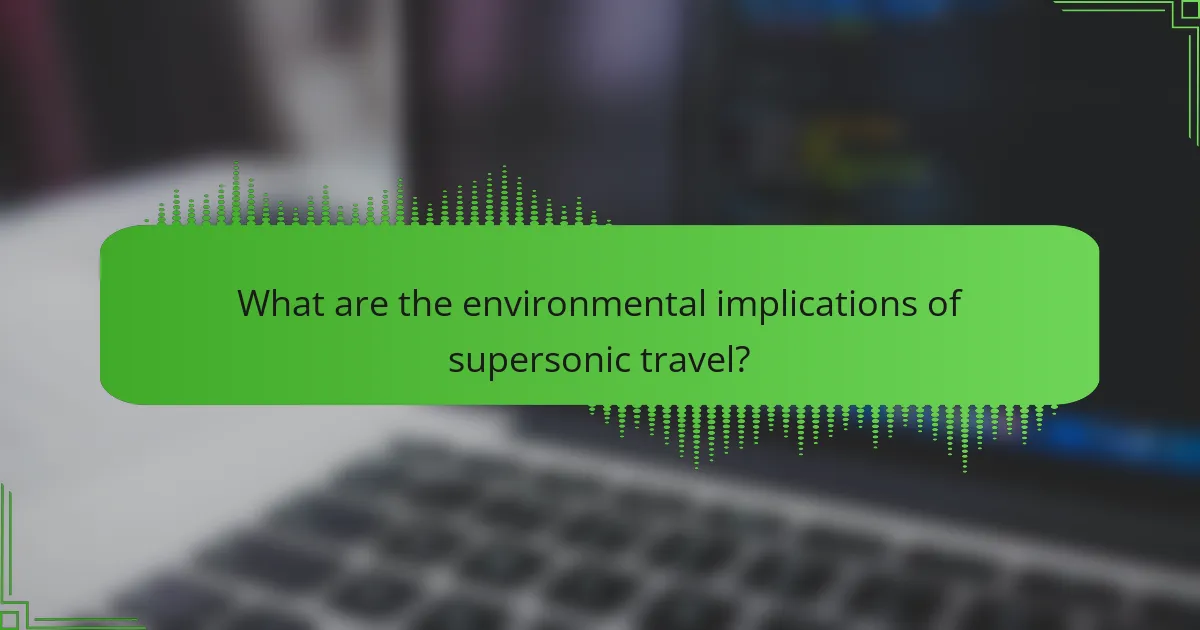Supersonic travel offers unmatched speed and luxury, exemplified by the Concorde. This article explores its historical milestones, operational challenges, and the future of supersonic technology. It also examines environmental impacts and emerging innovations aimed at making supersonic flight sustainable.

What were the key milestones in the development of Concorde?
The key milestones in the development of Concorde include its first flight in 1969, entry into service in 1976, and retirement in 2003. The project began in the early 1960s as a collaboration between the UK and France, aiming to revolutionise air travel. Notable developments included the successful test flights that demonstrated its supersonic capabilities, achieving speeds over twice the speed of sound. The Concorde’s unique delta wing design and afterburning engines were critical in overcoming the technical challenges of supersonic travel.
How did technological advancements shape supersonic travel?
Technological advancements significantly influenced supersonic travel by enhancing speed, safety, and efficiency. Innovations in aerodynamics, materials science, and engine design enabled aircraft like Concorde to achieve speeds over twice the speed of sound.
The introduction of advanced composite materials reduced weight and improved fuel efficiency. Engine technology saw advancements in turbojet engines, allowing for higher thrust with lower fuel consumption. Additionally, computer technology improved navigation and control systems, increasing safety during flight.
Challenges such as noise pollution and high operational costs arose from these advancements. Despite these issues, ongoing research aims to develop quieter and more economical supersonic jets, indicating a promising future for supersonic travel.
Which countries were involved in the Concorde project?
The countries involved in the Concorde project were the United Kingdom and France. These nations collaborated to develop the supersonic passenger aircraft, which first flew in 1969. The UK’s British Aircraft Corporation and France’s Aérospatiale were the primary manufacturers. The project faced numerous challenges, including high development costs and regulatory hurdles. Despite these issues, Concorde became an iconic symbol of advanced aviation technology.

What were the main benefits of flying on Concorde?
The main benefits of flying on Concorde included speed, comfort, and prestige. Concorde significantly reduced travel time, allowing passengers to fly from New York to London in under four hours. The aircraft offered luxurious amenities, including spacious seating and gourmet dining. Flying Concorde was an exclusive experience, often associated with high-profile travellers and celebrities, enhancing its allure.
How did Concorde impact travel time across the Atlantic?
Concorde significantly reduced travel time across the Atlantic, cutting flights to about three hours. This supersonic aircraft operated at speeds over twice the speed of sound, transforming transatlantic travel. Before Concorde, typical flight durations ranged from six to eight hours. The aircraft’s unique design, including its delta wing and powerful engines, allowed for such remarkable efficiency. As a result, Concorde not only set a new standard for air travel speed but also influenced future developments in aviation technology.
What luxury features distinguished Concorde from subsonic aircraft?
Concorde’s luxury features included spacious cabins, exclusive seating, and gourmet dining, distinguishing it from subsonic aircraft. The aircraft offered a unique experience with a maximum cruising altitude of 60,000 feet, allowing passengers to enjoy breathtaking views. Concorde’s soundproofing and advanced technology ensured a quieter, more comfortable flight. Additionally, its supersonic speed reduced travel time significantly, enhancing the overall luxury of the journey.

What challenges did Concorde face during its operational years?
Concorde faced several challenges during its operational years, including high operating costs, noise regulations, and limited routes. The aircraft’s fuel consumption was significantly higher than subsonic jets, impacting profitability. Additionally, sonic booms restricted flight paths over land, limiting its operational flexibility. Regulatory hurdles and safety concerns, particularly after the 2000 crash, further complicated its viability. Lastly, the rise of more efficient subsonic aircraft diminished demand for supersonic travel.
How did noise regulations affect Concorde’s routes?
Noise regulations significantly restricted Concorde’s flight paths, limiting supersonic travel over land. These regulations arose from concerns about sonic booms disrupting communities. As a result, Concorde primarily operated transatlantic routes, flying over oceans where noise restrictions were less stringent. This limitation affected the aircraft’s operational efficiency and market reach, ultimately influencing its commercial viability.
What economic factors contributed to the decline of Concorde?
The decline of Concorde was influenced by several economic factors. High operational costs made ticket prices prohibitive for many travellers. Additionally, the oil crisis of the 1970s significantly increased fuel expenses. Limited market demand for supersonic travel and competition from more efficient subsonic aircraft further strained profitability. Regulatory challenges and environmental concerns also contributed to its eventual retirement.

What are the environmental implications of supersonic travel?
Supersonic travel has significant environmental implications, primarily due to high fuel consumption and noise pollution. The Concorde, for instance, emitted more carbon dioxide per passenger than subsonic aircraft. Additionally, supersonic jets produce sonic booms, which can disrupt wildlife and human activities. As a result, the future of supersonic travel must prioritise sustainable technologies to mitigate these impacts.
How does Concorde’s carbon footprint compare to modern aircraft?
Concorde’s carbon footprint was significantly higher than that of modern aircraft. While Concorde emitted approximately 5,000 kg of CO2 per hour, modern aircraft have improved efficiency, averaging around 2,500 kg per hour. This reduction is due to advancements in engine technology and aerodynamics. Additionally, modern aircraft have adopted sustainable aviation fuels, further decreasing their environmental impact.
Which innovations are being explored to reduce noise pollution?
Innovations to reduce noise pollution in supersonic travel focus on advanced technologies. These include quieter engine designs, improved aerodynamics, and innovative materials. For example, NASA’s X-59 aircraft aims to minimise sonic booms, potentially allowing for overland supersonic flights without disruptive noise. Additionally, research into adaptive wing designs seeks to optimise performance while reducing noise levels. These advancements could reshape the future of air travel by addressing historical challenges associated with noise pollution.

What is the current status of supersonic travel technology?
Supersonic travel technology is advancing, with several companies developing new aircraft. The most notable is Boom Supersonic, which aims to launch its Overture jet by 2029. This aircraft promises to cut flight times significantly while addressing noise and environmental concerns. Additionally, NASA is exploring technologies to reduce sonic booms, potentially paving the way for commercial supersonic flights over land.
Which companies are leading the charge in developing new supersonic jets?
Boeing, Lockheed Martin, and Boom Supersonic are leading the development of new supersonic jets. Boeing focuses on sustainable technology, while Lockheed Martin aims to create quieter jets. Boom Supersonic’s Overture targets commercial travel with a capacity of 65-88 passengers and a speed of Mach 1.7. Each company addresses challenges in noise reduction and fuel efficiency, shaping the future of supersonic travel.
How are modern designs addressing the limitations of Concorde?
Modern designs are addressing Concorde’s limitations through advancements in fuel efficiency, noise reduction, and environmental sustainability. New supersonic jets utilise innovative materials and aerodynamics to minimise drag and improve performance. For example, companies like Boom Supersonic are developing aircraft that aim for lower operational costs and reduced sonic booms, enhancing the feasibility of commercial supersonic travel. Additionally, the integration of hybrid propulsion systems is being explored to further decrease carbon emissions, addressing environmental concerns associated with earlier supersonic models.

What lessons can be learned from Concorde’s legacy?
Concorde’s legacy teaches valuable lessons about innovation, sustainability, and the importance of balancing technological advancement with environmental considerations. The aircraft’s development showcased the potential of supersonic travel, yet its operational challenges highlighted issues like noise pollution and high operational costs. As a result, future endeavors in supersonic travel must prioritise eco-friendly technologies and economic viability to ensure successful integration into modern aviation. The Concorde experience emphasises that groundbreaking advancements should align with societal and environmental needs to achieve lasting impact.
How can future supersonic travel avoid Concorde’s pitfalls?
Future supersonic travel can avoid Concorde’s pitfalls by focusing on noise reduction, fuel efficiency, and environmental sustainability. Implementing quieter engine technologies will address sonic boom concerns, while advancements in aerodynamics can enhance fuel performance. Additionally, utilising sustainable aviation fuels can minimise carbon emissions. Investing in regulatory partnerships will facilitate smoother integration into air traffic systems.
What role does public perception play in the future of supersonic travel?
Public perception significantly influences the future of supersonic travel. As environmental concerns rise, public opinion shapes regulatory frameworks and airline strategies. Positive perceptions can drive demand, while negative views on noise and emissions may hinder progress. Consumer acceptance is crucial for the success of new supersonic technologies. Engaging the public through transparent communication and innovative solutions will be essential for overcoming skepticism and fostering a sustainable future in supersonic travel.
What best practices should be considered for future supersonic aircraft?
Future supersonic aircraft should prioritise noise reduction, fuel efficiency, and safety. Implementing advanced aerodynamics and materials can enhance performance. Sustainable fuels will be crucial to minimise environmental impact. Collaboration with regulatory bodies is essential for compliance and public acceptance. Continuous research into supersonic flight dynamics will drive innovation.


